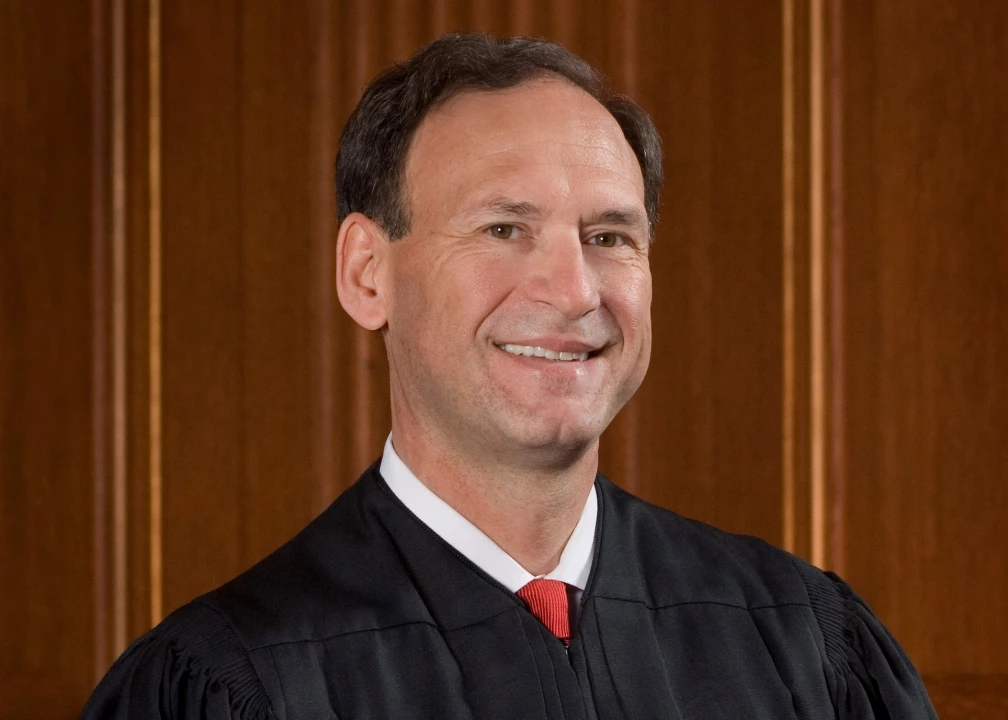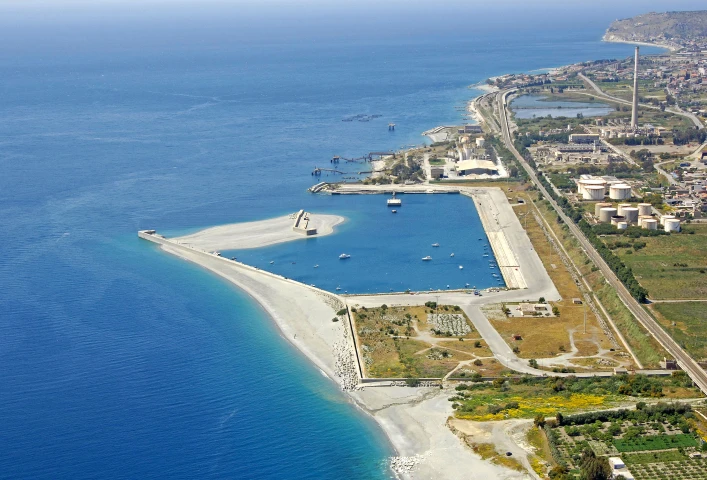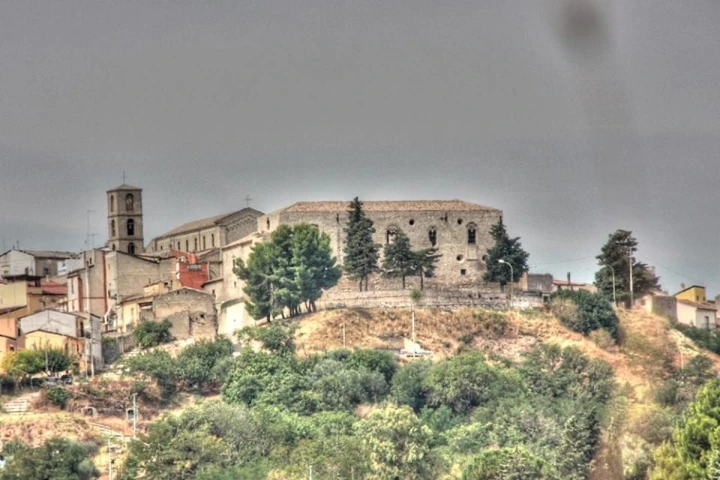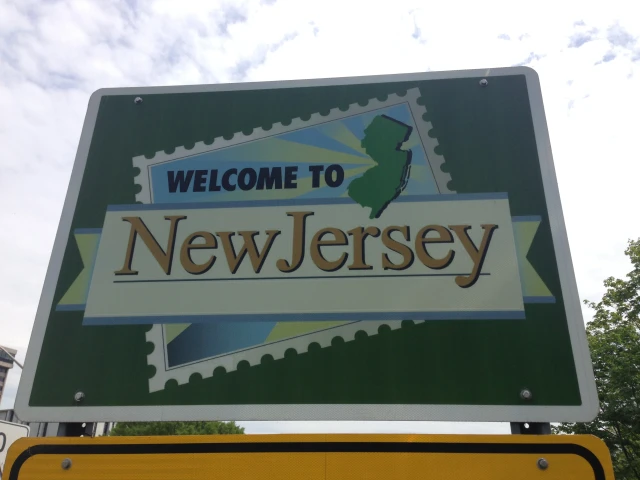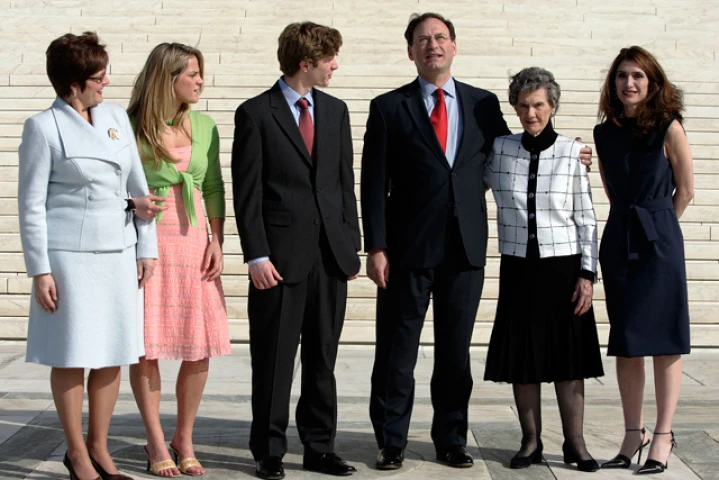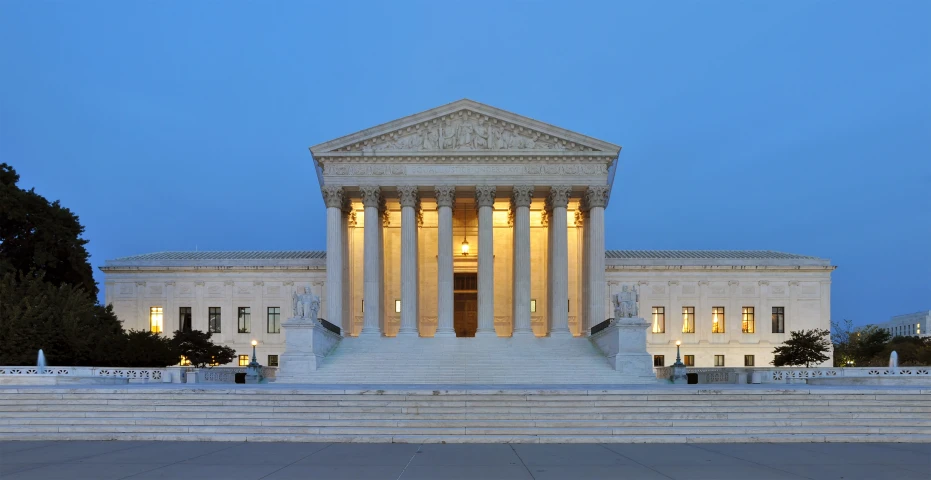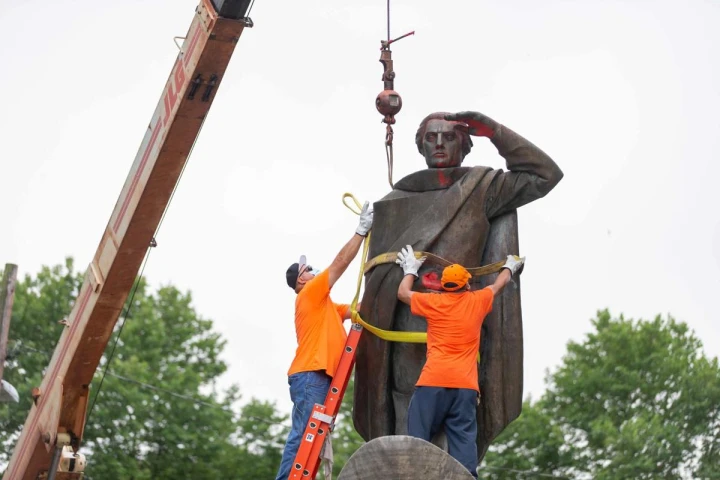I am sure that none of the wonderful protagonists of the 242 interviews published so far will be offended if I write that this one you are about to read is a bit more particular than the others. The prestige of the guest that We the Italians has the honor to host in this interview is absolute, and his exceptionality is unanimously recognized: his success and leadership honors the entire Italian American community, and together Italy and the United States are unified by the esteem and thanks they owe to such an enlightened figure.
I must thank my friend, the exceptional Gilda Rorro Baldassari, who was kind and generous enough to allow me to get in touch with Supreme Court Justice Samuel Alito, who accepted with great courtesy to answer some of my questions. It was my choice, given the delicate institutional moment, not to ask questions regarding the recent developments in the composition of the Supreme Court, let alone the presidential elections that will be held the day after the publication of this interview, for which I am infinitely grateful to Justice Samuel Alito, a perfect example of Italian American excellence. While maintaining our willingness to remain neutral in the elections, it seems to us that this is really the best way to honor the greatness of American democracy and the meritorious contribution that the Italian American community has given it and continues to give it.
Your honor, in which area of Italy are your roots, and what is the history of your family's emigration to America?
My father’s family came from a little town south of Reggio Calabria called Saline Joniche. As was the case with many immigrants, my paternal grandfather came to the United States first to find a job and a place for the family to live, and my paternal grandmother then came with my father, who was about six months old at the time, in 1914.
My mother’s family was from Palazzo San Gervasio in Basilicata. My mother was the youngest of the six children in the family, and she was born in the United States, while her oldest siblings were born in Italy. They came to the United States earlier than my father’s family. The story I heard was that the family decided to emigrate because the crops on their farm were destroyed one year in a hail storm.
Both families settled in Trenton, New Jersey, which was a manufacturing city at the time. My mother’s father worked in a steel mill, and my father’s father was a laborer in a variety of jobs.
One of the common traits of the millions of Italian Americans is the family: it seems to be very important, as it is for us Italians who live in Italy. Has it been and is it the same for you?
Yes, definitely. My parents always stressed the importance of family, and our nuclear family - my parents, my sister, and I - were very close. We also spent a lot of time with my aunts on both sides of the family. We had a family dinner at noon every Sunday and always saw the family on holidays.
My parents were devoted to my sister and me and did everything they could to give us a good start in life.
I continue to believe that family is extremely important, and my wife and I cherish our relationship with our own children.
Italy and the United States are two very different countries from many points of view, yet in their history there are clear mutual influences. The United States would not be what they are without the Italian contribution, nor Italy would be what it is without the American one. Have you had the opportunity to verify this influence during the success of your career?
Yes, this is true in many ways, both large and small. Italian Americans have made important contributions to their new country, and the influence of Italian culture is everywhere to be seen. To take just one example, the design of the Supreme Court building where I work is based on a Roman model, and I am quite sure that the wonderful marble work was done by Italian American masons.
You are correct that Italy and the United States differ in many ways, but we share core values, especially a devotion to democracy and the protection of human rights. When I was in college, I wrote my thesis on the Italian Constitutional Court, and I like to think that the United States Constitution and our Supreme Court had some influence when Italy’s new Constitution was drafted in 1948.
The Italian American community started from the emigrants who arrived in America in very difficult conditions, showing how exceptional the American environment is, which gives a chance to those who work hard and commit themselves with humility and commitment. Today, Italian Americans are successful in all the different sectors of the American life. You are probably the most important testimonial of this excellent union between Italian DNA and the American meritocratic environment. What is the most Italian trait of your character?
That’s a hard question, but I will say it is the value I attach to family and also to the past, including the people, places, and things that have been important to me.
Is there an aspect of the Italian way of life that you would copy and paste into the United States, if you could? And vice versa?
For the U.S., everything connected with food and dining. For Italy, less red tape.
What in your opinion are the main differences between Italy and the United States from the point of view of the role of the judiciary?
I think there has been some convergence in recent decades, but there is a fundamental difference between the role of a judge in a civil law system of the type that prevails on the continent of Europe and the role of a judge in the adversarial system used in English-speaking countries. This is most evident in criminal cases, where, in civil law countries, a member of the judiciary is involved in the prosecutorial process. In the U.S. and other English-speaking countries, judges play a strictly neutral role in such cases.
Until after World War II, in Italy and virtually everywhere else in Europe, judges were forbidden to review the constitutionality of laws adopted by legislative bodies, while we have been doing that in the United States for more than 200 years. After World War II, however, constitutional review was introduced in Europe. Italy and Germany took the lead, but now, this practice has spread throughout the continent. Indeed, because Italy is part of the European Union and the Council of Europe and is thus subject to decisions of the EU court and the European Court of Human Rights, judges may be seen as playing an even bigger role than in the U.S.
The last question concerns Christopher Columbus. One hundred years ago he was the target of the Ku Klux Klan because he represented religious diversity and the positive contribution of immigrants to the growth of the United States. Today those who consider these two factors important inexplicably attack him. What can be done to get him out of the role of scapegoat into which he has been unjustly dragged?
I am very upset about the movement to take down all Columbus statues and memorials and to get rid of Columbus Day. This movement sees Columbus as a symbol of colonialism and the oppression of Native Americans, but this misunderstands why these statues and memorials were originally put up and what they continue to mean for Italian Americans.
To understand this, a little bit of history is in order. Long before Italian immigrants came in great numbers to the United States, Columbus was already a powerful symbol. At the time of the founding of the United States and for many years thereafter, Columbus was a symbol of boldness, an enterprising spirit, and freedom from antiquated and deadening restrictions. That is why our nation’s capital is in the District of Columbia. It’s why many cities in the United States are named Columbus. It’s why famous American authors like Washington Irving and Walt Whitman wrote about Columbus. Columbus was seen as a hero because his discovery brought about European settlement in the New World, which was celebrated. Paradoxically, this very accomplishment is why many today see him as a villain.
What those who attack Columbus statues and other memorials do not seem to understand is that the great majority of these statues and memorials were put up by Italian Americans because of what Columbus symbolized to them. And to them, he symbolized something quite different. He symbolized their experience in coming to America and their claim to belong here just like everyone else. When Italian immigrants arrived here, they were often scorned. Many thought they were hopelessly backward and could never fit in. Looking for a way to say that they did belong, Italian Americans, exercising a bit of furbezza, simply latched onto the Columbus symbol that the general population already knew and valued. These immigrants, like my grandparents, were overwhelmingly poor and had little formal education. I venture to say that they did not know a lot about the details of Columbus’s actions in the New World. What they knew was that he was Italian; he took a great chance in leaving the Old World behind; he suffered hardships during his voyage, but ultimately he “discovered” America. And knowing these bare facts, they said to themselves: “That’s our story too. We took a big chance, left everything we knew behind, had a difficult time at first in our new home, but now we belong - because after all, our countryman discovered this place.”
As a young boy in 1959, I was present when the Italian American community of Trenton, New Jersey, proudly erected a statue of Columbus in the little park in the heart of their community, and I am quite certain that what I have outlined is roughly what they thought. The statue was a memorial to their community and what it had accomplished, and it was therefore very painful to me to see the statue defaced with red paint and eventually hauled away by the city a few months ago. The neighborhood in which the statue was located is now home to newer immigrants, and the removal of the statue effectively effaced any trace of the old Italian American community. It is as if the Italian immigrants never existed and their history - what they endured and accomplished - counts for nothing. That is a great insult to the memory of our ancestors, who had nothing to do with any of the things for which Columbus is now reviled.
As for what can be done to arrest the trend to wipe the country clean of any reference to Columbus, Italian Americans and others can explain what Columbus statues and memorials really meant to the people responsible for their erection and what they mean to Italian Americans today. And Italian Americans and others can speak up and stand up against what is going on.
Sono certo che nessuno dei meravigliosi protagonisti delle 242 interviste pubblicate finora si offenderà, se scrivo che questa che state per leggere è un po' più particolare delle altre. Il prestigio dell'ospite che We the Italians ha l'onore di ospitare in questa intervista è assoluto, e la sua eccezionalità gli è unanimemente riconosciuta: il suo successo e la sua leadership rende onore a tutta la comunità italoamericana, e insieme Italia e Stati Uniti sono accomunati dalla stima e dal ringraziamento che devono ad una figura così illuminata.
Devo ringraziare la mia amica, l'eccezionale Gilda Rorro Baldassari, che è stata così gentile e generosa da permettermi di entrare in contatto con il Giudice della Corte Suprema Samuel Alito, che ha accettato con grande cortesia di rispondere a qualche mia domanda. E' mia la scelta, visto il delicato momento istituzionale, di non fare domande riguardanti i recenti sviluppi della composizione della Corte Suprema né tanto meno le elezioni presidenziali che si terranno il giorno successivo alla pubblicazione di questa intervista, per la quale ringrazio infinitamente il Giudice Samuel Alito, perfetto esempio dell'eccellenza italoamericana. Mantenendo la nostra volontà di rimanere neutrali nella contesa elettorale, ci sembra che questo sia davvero il modo migliore per rendere onore alla grandezza della democrazia americana e al meritorio contributo che la comunità italoamericana le ha donato e continua a donarle.
Vostro Onore, in quale zona d'Italia risiedono le sue radici, e qual è la storia dell'emigrazione della sua famiglia in America?
La famiglia di mio padre proveniva da un piccolo paese a sud di Reggio Calabria chiamato Saline Joniche. Come molti immigrati, mio nonno paterno venne negli Stati Uniti per primo per trovare un lavoro e un posto per la famiglia, e mia nonna paterna poi lo raggiunse insieme a mio padre, che allora aveva circa sei mesi, nel 1914.
La famiglia di mia madre era di Palazzo San Gervasio in Basilicata. Mia madre era la più giovane dei sei figli, e nacque negli Stati Uniti, mentre i suoi fratelli maggiori erano nati in Italia. Arrivarono negli Stati Uniti prima della famiglia di mio padre. La storia che ho sentito è che la famiglia decise di emigrare perché i raccolti della loro fattoria erano andati distrutti un anno a causa di una fortissima grandinata.
Entrambe le famiglie si stabilirono a Trenton, nel New Jersey, che all'epoca era una città manifatturiera. Il padre di mia madre lavorava in un'acciaieria e il padre di mio padre era un bracciante che fece diversi lavori.
Uno dei tratti comuni ai milioni di italoamericani è la famiglia: sembra essere molto importante, come lo è per noi italiani che viviamo in Italia. È stato ed è lo stesso anche per Lei?
Sì, decisamente. I miei genitori hanno sempre sottolineato l'importanza della famiglia, e il nostro nucleo familiare più ristretto - i miei genitori, mia sorella ed io - era molto unito. Abbiamo anche trascorso molto tempo con le mie zie da entrambi i lati della famiglia. Ogni domenica a mezzogiorno c’era un pranzo familiare e comunque vedevamo sempre la famiglia nei giorni festivi.
I miei genitori volevano molto bene a me e a mia sorella e facevano tutto il possibile per darci la migliore vita possibile.
Continuo a credere che la famiglia sia estremamente importante: io e mia moglie teniamo molto al nostro rapporto con i nostri figli.
L'Italia e gli Stati Uniti sono due paesi molto diversi da molti punti di vista, ma nella loro storia ci sono chiare influenze reciproche. Gli Stati Uniti non sarebbero quello che sono senza il contributo italiano, né l'Italia sarebbe quello che è senza quello americano. Ha avuto modo di verificare questa influenza anche durante una carriera di grande successo come la sua?
Sì, questo è vero per molti aspetti, sia grandi che piccoli. Gli italoamericani hanno dato un contributo importante al loro nuovo Paese, e l'influenza della cultura italiana è ovunque visibile. Per fare un solo esempio, il progetto dell'edificio della Corte Suprema dove lavoro si basa su un modello romano, e sono abbastanza sicuro che il meraviglioso lavoro in marmo sia stato fatto da muratori italoamericani.
Lei ha ragione quando dice che l'Italia e gli Stati Uniti sono diversi sotto molti aspetti, ma condividiamo valori fondamentali, in particolare la dedizione alla democrazia e alla tutela dei diritti umani. Quando ero all'università, ho scritto la mia tesi sulla Corte costituzionale italiana, e mi piace pensare che la Costituzione degli Stati Uniti e la nostra Corte Suprema abbiano avuto una certa influenza quando la nuova Costituzione italiana fu redatta nel 1948.
La comunità italoamericana è partita dagli emigranti arrivati in America in condizioni molto difficili, dimostrando quanto sia eccezionale l'ambiente americano, che dà una possibilità a chi lavora sodo e si impegna con umiltà e impegno. Oggi gli italoamericani hanno successo in tutti i diversi settori della vita americana. Lei è probabilmente il più importante testimonial di questo eccellente connubio tra il DNA italiano e l'ambiente meritocratico americano. Qual è il tratto più italiano del suo carattere?
È una domanda difficile, ma penso che il mio tratto più italiano sia il valore che attribuisco alla famiglia e anche al passato, comprese le persone, i luoghi e le cose che sono state importanti per me.
C'è un aspetto dello stile di vita italiano che si potrebbe copiare e incollare negli Stati Uniti, se si potesse? E viceversa?
Per gli Stati Uniti, tutto ciò che riguarda il cibo e la ristorazione. Per l'Italia, meno burocrazia.
Quali sono secondo Lei le principali differenze tra Italia e Stati Uniti dal punto di vista del ruolo della magistratura?
Credo che ci sia stata una certa convergenza negli ultimi decenni, ma c'è una differenza fondamentale tra il ruolo del giudice in un sistema di diritto civile del tipo che prevale nel continente europeo e il ruolo del giudice nel sistema utilizzato nei paesi anglofoni. Ciò è più evidente nei casi penali, dove, nei paesi di diritto civile, un membro della magistratura è coinvolto nel processo penale. Negli Stati Uniti e in altri paesi anglofoni, i giudici svolgono un ruolo strettamente neutrale in questi casi.
Fino al secondo dopoguerra, in Italia e praticamente ovunque in Europa, ai giudici era proibito rivedere la costituzionalità delle leggi adottate dagli organi legislativi, mentre negli Stati Uniti lo facciamo da oltre 200 anni. Dopo la seconda guerra mondiale, invece, la revisione costituzionale è stata introdotta in Europa. L'Italia e la Germania hanno preso l'iniziativa, ma ora questa pratica si è diffusa in tutto il continente. Infatti, poiché l'Italia fa parte dell'Unione Europea e del Consiglio d'Europa ed è quindi soggetta alle decisioni del Tribunale dell'Unione Europea e della Corte Europea dei Diritti dell'Uomo, si può considerare che i giudici abbiano un ruolo ancora più importante che negli Stati Uniti.
L'ultima domanda riguarda Cristoforo Colombo. Cento anni fa era il bersaglio del Ku Klux Klan perché rappresentava la diversità religiosa e il contributo positivo degli immigrati alla crescita degli Stati Uniti. Oggi chi considera questi due fattori importanti, inspiegabilmente lo attacca. Cosa si può fare per farlo uscire dal ruolo di capro espiatorio in cui è stato ingiustamente trascinato?
Sono molto turbato dal movimento per l'abbattimento di tutte le statue e i monumenti commemorativi di Colombo e per la cancellazione del Columbus Day. Questo movimento vede Colombo come un simbolo del colonialismo e dell'oppressione dei nativi americani, ma così dimostra di non capire perché queste statue e questi monumenti commemorativi siano stati originariamente eretti e cosa continuino a significare per gli italoamericani.
Per capire questo, è necessaria un po' di storia. Molto prima che gli immigrati italiani arrivassero in massa negli Stati Uniti, Colombo era già un simbolo potente. All'epoca della fondazione degli Stati Uniti e per molti anni dopo, Colombo era un simbolo di audacia, di spirito intraprendente e di libertà da restrizioni antiquate e mortificanti. Ecco perché la capitale della nostra nazione si trova nel Distretto di Columbia. È per questo che molte città degli Stati Uniti si chiamano Columbus. È per questo che autori americani famosi come Washington Irving e Walt Whitman hanno scritto di Colombo. Colombo era visto come un eroe perché la sua scoperta portò all'insediamento europeo nel Nuovo Mondo, e questo veniva celebrato. Paradossalmente, proprio questo risultato è il motivo per cui molti oggi lo vedono come un personaggio negativo.
Chi attacca le statue di Colombo e altri monumenti commemorativi sembra non capire che la grande maggioranza di queste statue e monumenti sono stati costruiti dagli italoamericani a causa di ciò che Colombo voleva dire per loro. E per loro, egli significava qualcosa di molto diverso. Era il simbolo della loro esperienza nel venire in America e della loro pretesa di appartenere a questo Paese come tutti gli altri. Quando gli immigrati italiani arrivavano qui, spesso venivano disprezzati. Molti pensavano che fossero irrimediabilmente arretrati e che non sarebbero mai riusciti a inserirsi. Cercando un modo per dire che appartenevano, gli italoamericani, usando un po' di furbizia, si sono semplicemente agganciati al simbolo colombiano che la popolazione in generale già conosceva e apprezzava. Questi immigrati, come i miei nonni, erano poverissimi e avevano un basso livello di istruzione scolastica. Mi azzardo a dire che non sapevano molto sui dettagli delle azioni di Colombo nel Nuovo Mondo. Quello che sapevano era che era italiano; che corse un grande rischio nel lasciarsi il Vecchio Mondo alle spalle; che soffrì le avversità durante il suo viaggio, ma alla fine “scoprì” l'America. E conoscendo questi fatti, si sono detti: "Questa è anche la nostra storia. Abbiamo corso un grande rischio, ci siamo lasciati alle spalle tutto quello che sapevamo, abbiamo avuto un momento difficile all'inizio nella nostra nuova casa, ma ora le apparteniamo - perché, dopo tutto, il nostro connazionale ha scoperto questo posto".
Da ragazzo, nel 1959, ero presente quando la comunità italoamericana di Trenton, nel New Jersey, eresse con orgoglio una statua di Colombo nel piccolo parco nel cuore della loro comunità, e sono abbastanza sicuro che quello che ho raccontato è all'incirca quello che pensavano. La statua era un monumento alla loro comunità e a ciò che aveva realizzato, e quindi per me è stato molto doloroso vedere la statua deturpata con vernice rossa e infine portata via dalla città qualche mese fa. Il quartiere in cui si trovava la statua è ora la casa di nuovi immigrati, e la rimozione della statua ha cancellato ogni traccia della vecchia comunità italoamericana. È come se gli immigrati italiani non fossero mai esistiti e la loro storia - ciò che hanno sopportato e realizzato - non conti nulla. Questo è un grande insulto alla memoria dei nostri antenati, che non avevano nulla a che fare con le cose per le quali Colombo è ora offeso.
Quanto a ciò che si può fare per arrestare la tendenza a cancellare il Paese da ogni riferimento a Colombo, gli italoamericani e altri possono spiegare cosa le statue e i memoriali di Colombo significassero veramente per i responsabili della loro costruzione e cosa significano oggi per gli italoamericani. E gli italoamericani e altri possono parlare e opporsi a ciò che sta succedendo.


